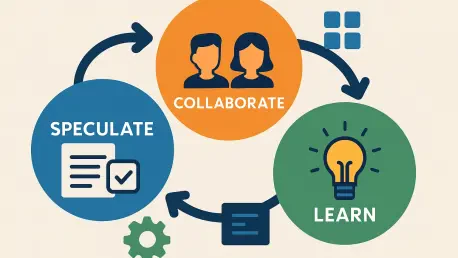Imagine a software project launched with high hopes, only to become a tangled mess of code within a few years, where even the smallest change requires weeks of effort and introduces countless bugs, a scenario all too common in the tech industry. Rigid methodologies often fail to keep pace with evolving business needs, but Adaptive Software Development (ASD) emerges as a solution to this pervasive challenge, promising a framework where systems can grow and adapt without crumbling under the weight of change. This review delves into the intricacies of ASD, exploring its principles, real-world impact, and potential to redefine how software is built and maintained in a dynamic digital landscape.
Unpacking the Essence of Adaptive Software Development
At its core, Adaptive Software Development represents a shift away from traditional, linear approaches like the Waterfall model, which often struggle with inflexibility in the face of shifting requirements. Born out of the need for agility, ASD prioritizes adaptability, allowing systems to evolve incrementally as user needs and market conditions change. This methodology is particularly relevant in today’s fast-moving tech environment, where rapid delivery and continuous updates are not just advantageous but essential for staying competitive.
The philosophy behind ASD hinges on creating software that can be modified with minimal friction, avoiding the pitfalls of complete overhauls or rewrites. Unlike older models that demand upfront perfection, this approach embraces change as a constant, encouraging developers to build systems that can pivot quickly. Its emphasis on iterative progress ensures that teams can respond to feedback and emerging trends without being locked into outdated plans, making it a cornerstone for modern product development.
Core Tenets and Tactical Approaches of ASD
Adaptive Software Development is built on a foundation of principles and strategies designed to foster systems capable of sustained evolution. These elements work together to counteract the natural decay of software over time, ensuring that projects remain manageable and responsive. A closer look at these components reveals how they shape the adaptability of codebases in practical settings.
Evolvability as the Bedrock of Longevity
Central to ASD is the concept of evolvability, which refers to a system’s capacity to adapt over time with reduced effort and risk. This principle directly addresses software entropy, a phenomenon where development speed diminishes as a codebase ages due to accumulating complexity. By focusing on evolvability, ASD aims to maintain a consistent level of effort for implementing changes, whether a project is in its first month or several years old.
This focus requires intentional design choices that prioritize flexibility over short-term optimization. For instance, modular architectures and clear separation of concerns help ensure that modifications in one area do not ripple destructively across the entire system. Such strategies mitigate the risks associated with aging software, preserving development velocity in the long run.
Iterative Cycles and Gradual Advancements
A hallmark of ASD is its advocacy for iterative development, favoring small, frequent updates over massive, infrequent revisions. This approach allows teams to make swift adjustments based on real-time feedback, aligning closely with the unpredictable nature of product evolution. Iterative cycles also accommodate inevitable team turnover, enabling new members to contribute without needing to unravel years of monolithic decisions.
By breaking work into manageable increments, developers can test assumptions and correct course before issues escalate. This method reduces the likelihood of large-scale failures, as each iteration serves as a checkpoint for assessing progress and refining direction. The result is a development process that mirrors the agility required in competitive markets, ensuring software remains relevant through constant refinement.
Testing as the Backbone of Adaptability
Testing plays a pivotal role in ASD, acting as a safety net that emboldens developers to embrace change without fear of breaking critical functionality. Approaches like Test-Driven Development (TDD) and the Testing Trophy model emphasize verifying behavior over specific implementation details, allowing for safe refactoring as requirements shift. Robust testing frameworks ensure that modifications can be made confidently, preserving system integrity.
Beyond merely catching bugs, testing in ASD serves as a mechanism for maintaining flexibility across iterations. Well-designed tests focus on outcomes rather than internal structures, meaning that underlying code can evolve without necessitating constant test updates. This balance is crucial for sustaining adaptability, as it prevents testing from becoming a bottleneck in the development pipeline.
Current Innovations in Adaptive Software Development
The landscape of ASD is continually evolving, driven by broader industry trends that enhance its applicability. A notable shift is the deeper alignment with agile practices, which amplify ASD’s iterative nature through frameworks like Scrum and Kanban. Additionally, the integration of DevOps principles supports continuous delivery, enabling seamless deployment of adaptive changes with minimal downtime.
Another emerging trend is the influence of remote collaboration tools, which have become integral to distributed teams practicing ASD. These platforms facilitate real-time feedback and iterative planning, ensuring that adaptability is not hindered by geographic barriers. Furthermore, the rise of AI-driven development tools offers potential for automating repetitive tasks, allowing developers to focus on strategic adaptations rather than mundane code adjustments.
The management of technical debt also sees innovation within ASD, with new perspectives emphasizing proactive refactoring over reactive fixes. Teams are increasingly adopting metrics to gauge evolvability, helping to identify areas of potential entropy before they impede progress. These advancements collectively signal a maturing of ASD, positioning it as a forward-thinking methodology in software engineering.
Practical Implementations Across Industries
Adaptive Software Development has proven its worth in diverse sectors, demonstrating versatility in addressing unique challenges. In e-commerce, companies leverage ASD to roll out frequent updates to user interfaces and payment systems, ensuring they meet shifting consumer expectations without disrupting operations. Such adaptability is critical in a field where seasonal trends and user feedback demand constant tweaks.
In fintech, ASD enables firms to integrate new regulatory requirements and security features into existing platforms with minimal friction. This capacity for rapid evolution helps maintain compliance while delivering innovative financial tools to users. Similarly, healthcare applications benefit from ASD by allowing providers to update patient management systems in response to evolving medical protocols, showcasing its ability to handle sensitive, high-stakes environments.
Unique use cases further highlight ASD’s flexibility, such as in startups validating product ideas through rapid feature grafting. By temporarily embedding new functionalities into existing systems, these organizations can test market fit without committing to full-scale development upfront. These examples underscore how ASD empowers industries to navigate change, delivering scalable solutions tailored to dynamic needs.
Obstacles and Constraints in Implementing ASD
Despite its advantages, adopting Adaptive Software Development is not without hurdles, often rooted in organizational and procedural challenges. Resistance to cultural change remains a significant barrier, as teams accustomed to traditional methodologies may struggle to embrace the iterative mindset required for ASD. Shifting to a culture of constant adaptation demands training and leadership buy-in, which can slow initial adoption.
Balancing simplicity with adaptability presents another complexity, as the drive to accommodate future changes can inadvertently lead to overengineering. Teams must navigate the fine line between building flexible systems and creating unnecessary abstractions that hinder progress. Additionally, iterative cycles risk scope creep, where continuous adjustments expand project goals beyond original intent, straining resources if not carefully managed.
Efforts to refine ASD practices are ongoing, with a focus on developing better tools for tracking evolvability and streamlining iterative workflows. Metrics that quantify adaptability are being explored to provide clearer benchmarks for success. Addressing these challenges is essential for ensuring that ASD remains a viable and effective approach across varying team structures and project scopes.
Prospects for Adaptive Software Development
Looking ahead, Adaptive Software Development stands poised to benefit from emerging technologies that could amplify its strengths. Machine learning, for instance, holds promise for predicting areas of potential software entropy, enabling preemptive refactoring before issues arise. Such predictive capabilities could transform how teams prioritize adaptability in their development cycles.
Cloud-native architectures also offer exciting opportunities, providing scalable environments that complement ASD’s iterative focus. These platforms facilitate rapid deployment and testing of changes, aligning seamlessly with the methodology’s goals. Anticipated breakthroughs in automated testing frameworks further suggest a future where manual oversight of adaptability is minimized, enhancing efficiency.
The long-term impact of ASD may lie in its contribution to sustainable software ecosystems, where systems are built to endure through resilience rather than periodic replacement. As methodologies and tools continue to evolve, ASD is likely to play a central role in shaping development practices that prioritize lasting adaptability. This trajectory points to a paradigm where change is not a disruption but a fundamental aspect of software design.
Final Reflections on Adaptive Software Development
Reflecting on this exploration, Adaptive Software Development proves to be a transformative methodology that tackles the inherent challenges of software evolution with remarkable efficacy. Its emphasis on evolvability, iterative progress, and robust testing offers a strong framework for navigating the complexities of modern development demands. The real-world applications across industries demonstrate its versatility, while emerging trends hint at even greater potential through technological integration.
Moving forward, teams are encouraged to invest in cultural shifts that support ASD adoption, prioritizing training to foster an iterative mindset. Exploring new metrics for assessing evolvability could provide actionable insights for sustaining adaptability over time. Additionally, leveraging advancements in automation and cloud technologies is seen as a practical step to enhance ASD’s efficiency, ensuring that software remains resilient in the face of inevitable change.









